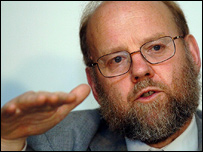Ian Wilmot, the scientist who created the cloned sheep Dolly, confesses in an interview that he abandoned cloning in favor of turning adult cells into stem cells. "The new approach will allow things to progress a little faster"

By Sally Lehrman, Scientific American
Sitting by the window of a luxury beach hotel in Half Moon Bay, California, in a blue sweater and khaki pants, Ian Wilmot does not look like the scientist responsible for one of the most dramatic experiments in the history of modern biology. When he and his colleagues unveiled Dolly the cloned sheep to the world in 1997, they ignited stem cell research, inspired awe in the general public, and caused panic over the looming cloning of humans. "Dolly surprised everyone," recalls Thomas Zwake, a stem cell biologist at the Center for Cellular and Genetic Therapy at Baylor College of Medicine. Cloned frogs refused to grow beyond the tadpole stage, and apparent success in mice ultimately proved to be a sham. According to the prevailing opinion at the time, cloning adult mammals using the methods used by Wilmot was biologically impossible.
During Dolly's adolescence, the cloning technology that created her, known as somatic cell nuclear transplantation (SCNT), developed into a high-budget research venture. Scientists hoped that they would eventually be able to take a cell from a patient with a serious illness such as Parkinson's disease, transfer its nucleus to an unfertilized human egg and clone embryonic stem cells that would be transplanted into the patient's damaged tissues and regenerate them. But the first clinical tests are still far from reach, the US government has imposed a ban on funding stem cell research and the field faces deep ethical controversies and technological challenges.
The 64-year-old Wilmot is one of the leading scientists who still remains fundamentally loyal to the SCNT method, but he is now leading a growing trend to abandon the field in favor of an alternative technology. This alternative approach, first demonstrated in 2006 by Shinya Yamanaka of Kyoto University, returns mature cells to an embryonic-like state, known as pluripotency, where the cells reacquire the ability to develop into any cell type. Any properly equipped laboratory can use this relatively simple method. "A high school lab can do this," says Dr. Mahendra Rao, director of the stem cell division at Invitrogen Life Sciences Corporation in Carlsbad, California. Yamanaka's approach also allows scientists to jump over the egg supply hurdle that complicates the SCNT method, and avoid ethical issues related to the destruction of human embryos.
A new and simpler approach

The technical problems, and not the lack of scientific value, are apparently driving the abandonment of the SCNT approach. Wilmot describes the step he himself took as a by-product of the large amount of time he has to invest in his new job as director of the Scottish Center for Stem Cell Therapy in Edinburgh, a position he took over in 2007 after almost 30 years at the nearby Roslyn Institute. The twenty senior researchers who work under him at the institute demand his attention, and the new job takes him almost completely away from the research he leads on Lou Gehrig's disease (ALS). "The new approach will allow things to progress a little faster," he says.
The SCNT method requires extremely high skill and expensive equipment. It is easy to damage the unfertilized eggs, and it is difficult to make the donated nucleus work in coordination with the surrogate egg. In the fall of 2007, researchers from the University of Oregon announced the first success in primates, but the group needed 304 eggs from 14 "rhesus" boxes to create only two cell lines, one of which had a defective Y chromosome. In humans, the difficulty of collecting fresh eggs is also a very high barrier, especially because by law scientists are prohibited from paying donors.
Yamanaka's method, which transforms mature mouse cells into embryonic stem-like cells called induced pluripotent (iPS) cells, has injected new blood into stem cell medicine. In this process, the scientists use viruses to insert three or four genes into the adult cell, reprogramming it and returning it to its pre-differentiation state. This process allows the cell to develop into any cell type. Over the course of a few months, Yamanaka's group and three other groups reported success using human cells derived from a baby's skin, joints, or foreskin.
Today it is already difficult to find a laboratory that concentrates only on embryonic cloning. Jamie Thomson for example, the first to grow living cells from a human embryo in culture, recently moved to run an institute that focuses mainly on iPS cells. Although the technique is not effective yet, and less than XNUMX percent of the cells become pluripotent, scientists believe that the iPS approach will provide a faster path to creating cells suitable for the study of diseases, and eventually also for healing.
The use of iPS, Wilmot enthuses, allows his group to research cell lines instead of struggling to produce them. "All you have to do is take some skin cells from someone who inherited the disease, sprinkle some 'magic powder' on them and wait three weeks," he says. "And you have pluripotent cells."
Is there any point in continuing the clan?
Scientists still do not fully understand how the reprogramming of iPS cells occurs. The inserted genes may serve as a basic control circuit, or activate other genes. It is also unclear whether these cells differ in any way from embryonic stem cells. No one has yet grown the two types of cells side by side and compared them, and the degree of survival after transplantation remains unknown for both types of cells.
iPS cells may prompt biologists to abandon conventional definitions of differentiated cells, says Zwake, whose lab studies characteristics of embryonic stem cells. It is possible, he says, that an embryonic cell does not have to go through the full developmental pathway to become a certain type of cell. There may be a series of "super controllers" that will allow, for example, a skin cell to become a mature nerve cell without going through the embryonic stage.
Despite going the iPS route, Wilmot and other pioneers of the cloning field insist that stem cell research must continue. The SCNT method has provided important insights into biology and will continue to allow studying programming and reprogramming of cells outside the genome. Only embryonic cells can answer questions concerning fertility and the early development of a human embryo. Presumably, scientists will also rely on SCNT to produce laboratory animals from the mammalian class to be used as models for diseases such as multiple sclerosis, or for agricultural applications such as the production of human proteins in animal milk.
But while scientists are turning their attention to other avenues, opponents of stem cell research have jumped at the chance and gone on the attack. "There is no valid reason for human cloning of any kind" or the destruction of embryos, wrote Tony Perkins, of the Family Research Council. It is hard to escape the feeling that SCNT studies are fading. The ethical barriers and the lack of eggs are still daunting. If iPS proves itself, Wilmot predicts, cloning will one day become a passing episode.
The full article was published in the October issue of "Scientific American"
For previous information on the subject on the science website: The "father" of Dolly the sheep retracts his support for cloning

2 תגובות
There is a situation for eternal life in 20-30 years
In short, do bone marrow cells taken from my clone have the potential to give me eternal life?